
Included is a candid shot of a common sight in my area of Italy: the Roman villa. As you can see, many people have vineyards, but perhaps more surprisingly, palm trees are very common in this area as well. The wall is crumbling, there is wet wash hanging on a line. This is the Rome not seen in the guidebooks, but I've been seeing a lot of it firsthand!
For a European city, Roma is comparitively dirty. They don't seem to have a trash-collector's union/guild like in Germany or Switzerland. Most of the apartment building are smoke-shadowed and aging, but painted pleasing pastel colors. There is the constand threat of pick-pocketing on the metro and around large tourist attractions; violent crime is rare in Rome but petty theft is rampant. I was almost attacked by gypsies on the Spanish Steps! I was with a friend at the time, which was lucky because I had no idea what was happening until it was all over, but he was aware and ready for anything. Apparently two of them converged behind us as we began our descent down the Steps, but I began to run down the Steps quite fast just for fun, and apparently they did not want to draw attention to themselves by following us. Lucky! They have quite developed strategies for robbing, involving children or pretending to sell something. Supposedly the best way is to utterly refuse to let them touch you, and not to allow them to move behind you and slash your backpack. I haven't had any trouble, but I am cautious when I am in crowds!
I saw some very interesting things when I ventured into Rome a second time: I especially enjoyed the Capuchin Crypt, or "Bone Church" located on the Via Veneto. The church above the crypt is a functioning one, but I merely visted the rooms below, which was packed with the remains of hundreds of monks. Chandeliers of clavicles! Stacks of skulls! There were tiny half-mummified monks reclining in their moldering robes in alcoves and a chilling inscription at the finish, "What you are, we used to be. What we are, you will be."
After the Capuchin monks I visited the Spanish Steps (anticlimactic) and afterward the Keats-Shelley Memorial House, which is the house where Keats breathed his last and which has been subsequently converted into a museum housing a great deal of memorabilia. Byron and Wordsworth were also honored, but to a lesser extent. The house itself was a darling little dose of Victorian quaintness, with creaking wood floors, heavy drapery and the smell of books. They had quite a few of Percy and Mary Shelley's personal correspondence, perhaps the most poignant of which was a letter from Percy Shelley to a medical friend requesting a lethal dose of prussic acid (a derivative of cyanide that was a popular mehod of suicide at the time) not to take immediately--he assured the friend--but merely for the comfort of holding "the key to the chamber of perpetual rest". The room in which Keats died from tuberculosis was tiny and narrow, with a rusty red tiled floor and sea-green walls. The Memorial House possessed both a death and life mask of Keats, and from those I have quite a good sense of what he looked like...far better than from a formal portrait or an etching. There is also a revealing little sketch done by the one friend in attendance on Keats around 2am the night before the poet died the next morning. The sketchis titled "2 o'clock, done by candlelight to keep me awake," and depicts Keats' blank face and sweat-curling hair as his head rests on his pillow.
Quite interesting.








 After the visit to the chruch of Santa Croce, three friends and I decided to walk from Rome back to campus along the Via Appia Antica, more commonly known as the Old Appian Way. I do not know how long the section of the road was that we walked, but it takes 30 minutes to cover the same distance by bus on the parallel Appia Nuova. We started out on a radiant Saturday afternoon, and two things became apparent after several hours of brisk walking. 1) The shoes I was wearing had inadequate arch support and 2) I had made the mistake of attempting this feat with three guys as my walking companions, two of whom stand over six feet tall and have considerably longer legs than I do. Take a break? Of course, if you have to. Walk slowly? Of course, if you need to. Needless to say, we didn't do much of either. ;)
After the visit to the chruch of Santa Croce, three friends and I decided to walk from Rome back to campus along the Via Appia Antica, more commonly known as the Old Appian Way. I do not know how long the section of the road was that we walked, but it takes 30 minutes to cover the same distance by bus on the parallel Appia Nuova. We started out on a radiant Saturday afternoon, and two things became apparent after several hours of brisk walking. 1) The shoes I was wearing had inadequate arch support and 2) I had made the mistake of attempting this feat with three guys as my walking companions, two of whom stand over six feet tall and have considerably longer legs than I do. Take a break? Of course, if you have to. Walk slowly? Of course, if you need to. Needless to say, we didn't do much of either. ;)










